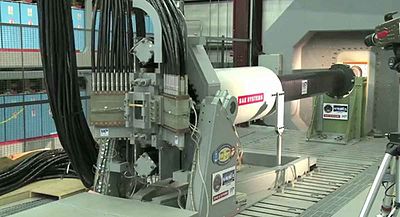Railgun
Created by Franklin Maxwell (fmaxwell6)
A railgun is used to launch conducting projectile at a high rate of velocity using only the forces deriving from electric and magnetic forces. The system is comprised of two parallel conducting "rails", a conducing projectile to be launched, and a battery to complete the circuit and to produce the current required to fire the projectile. Railguns are most often thought of as a type of kinetic energy weapon, meaning they use their momentum to create their destructive power instead of an explosive payload. While there are other types of kinetic energy weapons around today most of their speeds top out at Mach 3, where as a railgun theoretically could reach speeds in excess of Mach 10, however current prototypes are in more if the Mach 6 range.

The Main Idea
A railgun uses the principles of electromagnetics to create a weapon out of a conducting rod which is accelerated using the Lorentz Force in order to make the rod a projectile. The Lorentz Force combines the electrical force of a current carrying wire with the magnetic force coming from the the moving charged particles that make up the current in that wire.

A Mathematical Model
The Lorentz Force is the primary component in creating a railgun and is best know by the formula below:
[math]\displaystyle{ {F} = I\int \mathrm{d}\boldsymbol{\ell}\times{B} }[/math]
The direction of the force is found by using the right hand rule and pointing your hand in the direction of the current, folding your fingers in the direction of the magnetic field at that point, and then your thumb points in the direction of the force.
Applications of Railguns
As of now most the research, funding, and development for railgun weapons comes from the United States Navy. Phase I of the Electromagnetic Railgun Innovative Navy Project (INP) was started in 2005 with the goal of being able to create a 32 mega-joule muzzle energy device which has sense been completed. The Electromagnetic Railgun INP is now focussed on the advancements in technology which are needed for the weapon to operate at the 10-rounds-per-minute rate of fire that the Navy desires. The end goal is to have a kinetic energy weapon capable of a range of 100+ miles while also being able to reduce the amount of explosives on board the ship and decreasing the dangerous possibility of unexploded ordnance being left on the battlefield.

NASA
In order to find safer and less expensive means of space travel NASA has proposed the idea of launching payloads in to orbit using a two mile long railgun. The process would prove much safer for astronauts by taking out the highly explosive rocket fuel currently used to propel them into orbit, and for the same reason it would be a faction of the cost since the energy required would be significantly less. Another bonus is the flexibility that would be allowed. As opposed to current rockets which could never be launched on consecutive days, a railgun would allow another launch as soon as there was enough potential in the batteries.
Connectedness
- How is this topic connected to something that you are interested in?
Like most Tech students I am interested in all of the newest technologies and their variety of applications. Both the implications on the military side and space travel side are fascinating and could easily influence our lives and certainly the lives of future generations.
- How is it connected to your major?
As a Computer Engineering major there are many connections with electromagnetics in my major. Specifically there will be many connections with the hardware and software components of any railgun which is what I am specifically interested in.
- Is there an interesting industrial application?
The idea of commercial space travel could be greatly helped out by the advent of a railgun which would launch customers in to orbit for much cheaper than is now imaginable.
History
The physics behind a railgun and the Lorentz Force has been known many years since Oliver Heaviside discovered in it 1889, five years before Hendrik Lorentz derived it. In 1919 frenchman Louis Octave Fauchon-Villeplee filed the first U.S. Patent for a rail gun type device calling it an "Electric Apparatus for Propelling Projectiles." However only in recent decades has it been a practical option for much of anything due to the large amounts of potential and current it requires to produce a meaningful force. The United States Navy for example started heavily researching the capabilities of the railgun due to their new Zumwalt-class Destroyer which can produce 78 megawatts of power when it only needs 20 megawatts to operate, leaving 58 for the requirements of the railgun.
References
http://www.onr.navy.mil/media-center/fact-sheets/electromagnetic-railgun.aspx
http://www.popsci.com/article/technology/navy-wants-fire-its-ridiculously-strong-railgun-ocean
http://www.google.com/patents/US1421435?dq=Fauchon-Villeplee